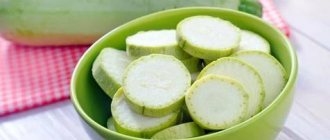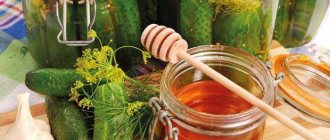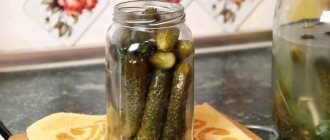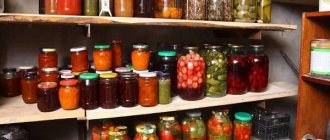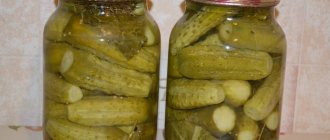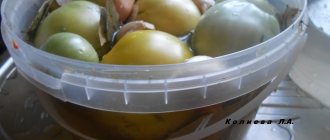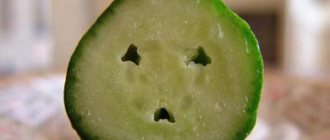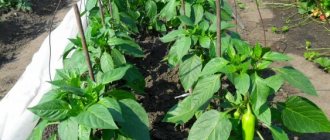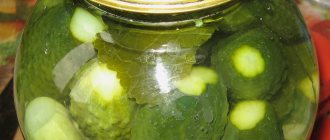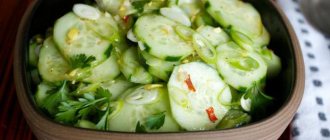Which cucumbers are suitable for winter preservation?
Both greenhouse varieties and cucumbers grown in open ground are suitable for harvesting for the winter. Although experienced housewives prefer the latter option, since such vegetables are more aromatic and tasty.
The main characteristics of good pickling cucumbers include the following criteria:
- a small number of seeds in the fruits;
- the presence of black spines and the tuberous surface of the peel;
- the size of the vegetable does not reach more than 15 cm;
- the skin of the vegetable has a rich green color, which is not lost when pickling;
- crispy pulp, no voids inside the cucumber.
Preservation storage rules
Storing crispy pickles can be challenging. They must be kept in a cool place. A cellar or pantry is ideal for this. But in a city apartment it is quite difficult to find a dry, cold place. You can allocate a balcony or a shelf in the refrigerator for this purpose. If this is not possible, you need to find any suitable dry place where light does not penetrate and the temperature remains low.
If a jar of cucumbers has been opened, the contents should be eaten as quickly as possible. The remaining vegetables are kept in brine, because without it they will quickly turn sour. Opened containers are stored for no longer than 5–10 days. The optimal temperature for pickles is from -1 to +3 °C. Due to heat and excess moisture, they rot.
If pickling was carried out without vinegar or other preservatives, then in the refrigerator or dark cellar they last up to 8 months. The presence of vinegar-containing compounds in the marinade greatly increases the shelf life of the preparations - from 1 to 2 years (depending on the concentration). Their taste and color practically do not change.
Attention! Eating pickles that were prepared more than 2 years ago is absolutely dangerous. In addition, they lose a lot in quality, become discolored, and become cloudy. Already by these external signs they can be rejected. It is best to eat the preparations within 1 year - during this period the taste qualities are revealed most fully.
Homemade pickles for the winter are an unusually tasty and nutritious treat that the whole family will enjoy without exception. You can choose any recipe and prepare this dish to your liking. Pickling cucumbers will require care and hygiene, as well as proper storage of the preparations.
Although long Chinese cucumbers are considered an exotic product, pickling them is not much different from preparing ordinary cucumbers for the winter. Following simple recommendations and taking into account the features of this miracle product, it is easy to prepare excellent pickles from it, which differ favorably from the usual ones with their pleasant aroma.
From the article you will learn how to pickle long Chinese cucumbers for the winter.
Which ones are not suitable?
When canning for the winter, you should avoid vegetables with the following symptoms:
- overripe, large cucumbers;
- vegetables from supermarkets;
- gnarled, irregularly shaped cucumbers;
- fruits with white pimples;
- thin-skinned vegetables;
- grafted fruits with a yellowish coating;
- washed cucumbers.
Pickling cucumbers with citric acid in a 3 liter jar
for a 3 liter jar we need:
- cucumbers - 2 kg
- horseradish leaf - 1 piece
- garlic - 4 cloves
- bay leaf - 2 pcs
- dill
brine for 1.5 liters of water:
- salt - 1.5 tbsp. l.
- sugar - 1.5 tbsp. l.
- citric acid - 1.5 tsp.
Wash the cucumbers well and cut off the ends on both sides. Place herbs, garlic, spices in a jar and pack the cucumbers tightly. Fill with bottled water and leave for 15 minutes. Then we drain it.
Prepare the marinade: add all the necessary ingredients to the water and boil. Then pour the hot brine into the jar and roll up the lid. Turn the jars over and leave to cool. After everything has cooled down, put it away for storage.
Is it possible to salt and marinate?
It’s worth taking a closer look at the varieties of cucumbers to decide which ones are perfect for pickling and which ones are not recommended.
Greenhouse and greenhouse cucumbers
Cucumbers from a greenhouse are less often used for pickling for the winter than those grown in open ground. And yet, this category also has its favorites, which are preferred by experienced housewives.
The list of pickling vegetables includes the following varieties:
- Marfinsky;
- Manul;
- Home;
- Relay race;
- Solar;
- Martha.
This is not a complete list of pickling varieties grown in greenhouses and greenhouses.
April cucumbers
You can determine whether a cucumber is suitable for pickling by its description. April F1 belongs to the category of hybrid varieties. This is a parthenocarpic self-pollinating vegetable, which is successfully grown by summer residents both in open and closed ground. They do not exceed 25 cm in size and have a tuberous surface. According to gardeners, this hybrid is excellent for pickling and pickling. In addition, it ripens together, which allows you to avoid stretching out the seaming process over a long period.
See also
Recipes for salting dry milk mushrooms hot and cold at home for the winter
Read
Lukhovitsky
Lukhovitsky cucumbers have been grown by residents of this city for a long time and are ideally suited for pickling for the winter. The soil and climatic conditions of this town near Moscow make it possible to harvest a crop that has an appetizing crunch, thin skin and pulp without voids.
They ripen early, are not afraid of diseases that affect this crop, and are resistant to cold. They are suitable for fresh consumption and for storing for the winter.
Smooth
It is not recommended to cover cucumbers with smooth skin for the winter. In the marinade, they become tasteless, fall apart in the jar, and you won’t get an appetizing crunch from such vegetables. It is better to use such fruits for fresh consumption.
Yellow cucumbers
As a rule, yellow cucumbers are not used for pickling; they are used for salad. To do this, peel them and cut out the core with coarse seeds.
Five signs of pickling cucumbers
Experts recommend paying attention to several indicators that will help you choose quality cucumbers. These will make crispy and fragrant preparations for winter. It is important to first figure out where to buy. If we talk about supermarkets, then most likely they sell salad cucumbers. They may be of excellent quality, but they have nothing to do with conservation. A good way out of the situation is to go to the market. But even here a surprise awaits: cucumbers are different in size, color and even the quality of the peel. A reasonable question arises: which ones are suitable for pickling?
There is no point in re-reading kilograms of specialized literature and becoming an expert in cucumber varieties. It’s enough just to know a couple of simple methods to determine which of the variety of types is suitable for your purposes.
1. Size, which turns out to matter. Rarely does anyone salt vegetables in barrels these days. A more popular container for this purpose is a glass jar, which means the size of the cucumbers should be appropriate - small, maximum 13 cm, and you definitely shouldn’t take crooked, humpbacked ones or those that look clearly unappetizing. 2. Bright green color is an obvious sign of a young cucumber in its juice. It is clear that a lot depends on the color, but pallor and yellowness are inherent only in old and overripe specimens. Not only can they be preserved, they are even unpleasant to eat. 3. Pimples on cucumbers are not only beautiful, but also correct. Yes, it is the cute thorns on the green peel that indicate the suitability of this species for pickling. There is even a superstition: cucumbers with tubercles do not explode. The fact is unproven, but folk wisdom does not arise without foundation, which means there is something in it. A little secret from experts: the white pimples indicate that this representative of the cucumber genus grew up in a greenhouse. It is suitable for pickling, but those with black needles have a better crunch. 4. Its tail will help ensure the freshness of the product. In recently picked cucumbers it is elastic. These should be given preference. Lethargic is not the same anymore. Although soaking the house in cold water for several hours will help restore their “vigor”. 5. Thick peel is the key to crispy pickling. A sure way to understand how canned cucumbers will delight you with their crunch on a frosty day is to check the strength of the peel in time. If the greenery cannot be pierced with a fingernail, then this is exactly what you need. A thin peel will not give the desired effect, and the cucumbers will become soft when closed.
It’s not worth taking a lot at once. First, it would be good to make sure of their taste and lack of bitterness. Only after tasting will it be possible to finally be convinced of the suitability of cucumbers for pickling.
Recipes for pickling cucumbers are not very diverse. They are based on water, salt, and garlic. Then the herbs and spices vary. The preparation procedure begins with soaking, which lasts from 2 to 10 hours. You should not keep cucumbers in water longer, otherwise they will begin to sour. White spots and soapy circles on the water are obvious signs that vegetables are spoiling. This means it’s time to rinse it under running water and put it in a jar.
Interesting point: do you need to cut off the tail of cucumbers before placing them in containers for pickling? It is in this part of the cucumber that nitrates accumulate. It is clear that there is no definite correct answer, and everyone does as they see fit, but it is advisable not to take risks and get rid of the “malicious” tail.
Canning greenhouse cucumbers
Of course, one of the most grown greenhouse vegetables is the cucumber. This is facilitated by the successful work of breeders who create high-yielding, ultra-early and very hardy varieties. Many of the modern cucumber varieties cultivated in greenhouses are suitable for pickling and preservation - their descriptions, photos, reviews of cultivation and use are presented in the article below.
Features of cucumbers and their cultivation in a greenhouse
Cucumbers are divided into 3 groups according to the method of using greens:
Attention! Among the variety of cucumbers, large-tubercular ones are the crispiest; the preservation of this property even after pickling is facilitated by the presence of transverse vascular bundles in the cucumber pulp.
The latter are characterized by compact size, thin tuberous skin with black spines, and elastic, dense flesh. For canning, universal varieties can also be used, the greens of which have reached a size of 6-12 cm. Salad varieties are good for fresh consumption and the preparation of lightly salted cucumbers for quick consumption.
Regardless of the purpose of greens, cucumbers selected for canning must meet the following parameters:
thin peel and dense core;
The quality of pickled cucumbers is affected by the ripening period of the greens. Early and ultra-early ripening varieties are considered less suitable for preservation than mid- and late-ripening varieties. In addition, experienced housewives have noted that pickled cucumbers at the end of summer or autumn turn out to be more tasty than those collected at the beginning of summer.
Recently, the greenhouse method of growing cucumbers has become particularly widespread. Its main advantages are:
the possibility of obtaining ultra-early and very late harvests;
independence from weather and climatic conditions;
creating optimal conditions for the development of cucumber vines, and, accordingly, obtaining higher yields.
The only drawback of cucumbers grown in a greenhouse is that the taste of cucumbers grown in open beds is always brighter and richer.
Attention! Self-pollinating and parthenocarpic varieties and hybrid forms are best suited for cultivation in greenhouses of any type. When selecting varieties to grow pickling cucumbers in a greenhouse, you should pay attention to its size, peel thickness, and pulp density.
Among the parthenocarpic varieties, the best are those that are able to form many ovaries in one bunch. Bunch greens are small-fruited, elastic, and have a good taste.
The best varieties for pickling
There are a huge number of varieties of cucumbers for harvesting for the winter. Become familiar with their name before purchasing seeds and study the description of the variety or hybrid.
Greenhouse
You can also roll greenhouse cucumbers, but it is important to choose the right variety. The list of the best representatives includes the following:
- Pickling. The fruits of this variety do not grow more than 11 cm, which is very convenient for canning in liter jars. There are small spikes and light stripes along the entire surface of the vegetable. The shape of the greens is slightly rounded. The advantage of this variety is that it is resistant to most crop diseases.
- Nezhinsky 12. The variety has good yield indicators and is popular among gardeners. Small oval greens crisp up perfectly when pickled, are not watery and have a pleasant taste. Small black dots cover the entire surface of the vegetable.
- Zozulya F1. A hybrid that is suitable for both indoor and open ground. The advantage is that there is no need for pollination by bees. The oblong and smooth vegetable begins to be harvested on the 40th day from the moment of planting. Shows high yields.
- Goosebumps F1. Another hybrid, suitable for both pickling and canning. Resistant to temperature changes and common diseases. Its crispy structure and bright, pleasant taste make it one of the leaders among summer residents.
For open ground
The choice of varieties for open ground is much wider. Among the favorites are the following varieties:
- Mother-in-law F1. Black-thorned and medium-tubercular fruits grow up to 10-12 cm. The vegetable is not afraid of sudden cold snaps and temperature changes. The main thing is to pick cucumbers on time, as they tend to overgrow.
- Boy with thumb F1. A hybrid that belongs to the gherkin category and is ideal for pickling for the winter. The pulp, homogeneous and without voids, is not bitter and has small seeds. The vegetable grows on average to 8-10 cm.
- Dark girl F1. The fruits have black spines and are 10-12 cm in size. The pulp is without bitterness, tasty and crispy.
See also
How to properly pickle cucumbers for the winter in jars so as not to explode, recipes with citric acid and aspirin
Read
Assorted tomatoes and peppers
Canning cucumbers along with tomatoes and sweet peppers gives the preparation a delicious taste. To make the fruits fragrant and crispy, it is better to marinate them with oak leaves, adding 2 to 3 pieces to each container.
Product set:
- 1500 ml water;
- 3 pcs. carnations;
- 10 g Jamaican pepper;
- 24 g coarse salt;
- 100 ml vinegar;
- 60 g granulated sugar;
- 1 large head of garlic;
- 1 large onion;
- 250 g orange or red pepper (bell pepper);
- cherry, oak and currant leaves;
- 2 – 3 large leaves of horseradish;
- 550 – 600 g cucumbers;
- a small bunch of parsley;
- 900 g of medium-sized cream tomatoes;
- 3 - 4 dill umbrellas.
Canning step by step:
- Rinse the greens under running water and place in jars. Small leaves are whole; large leaves can be torn into several parts.
- Place tomatoes, onion slices, chopped peppers, chopped garlic and cucumber slices in a container in layers.
- Pour boiling water over the vegetables and let them sit for 10 minutes.
- Pour the cooled water into a saucepan, let it boil, pour it back into the glass container and leave for 10 minutes.
- Drain the water again and add granulated sugar, vinegar and salt, put on the stove.
- Place spices in jars, pour boiling marinade over them and immediately roll up.
- Turn the lids down and leave until cool. Don't wrap it up.
See also
Which salt is better to salt cucumbers for the winter, plain or iodized? Read
In addition to the listed ingredients, you can add small pieces of zucchini and carrots, cauliflower, previously divided into inflorescences.
Rules for collecting cucumbers for preservation
To get a crispy and tasty product, it is important to properly collect cucumbers for canning. This is done either in the early morning or in the evening when the sun begins to set. Carefully separate the vegetables from the vines, trying not to damage the bush. If there is a long transportation ahead, the flowers at the ends of the cucumbers are not removed, this way they will be better preserved.
How to select and prepare ingredients
The quality of pickles depends on the correct selection and preparation of the product. For pickling, fresh, smooth and dense fruits without spots are selected, washed each separately with a soft brush and soaked for 5-10 hours in water, replacing it with fresh water every two hours.
This will make the cucumbers more elastic, crunchy and free them from nitrates. The tails are removed, and the vegetables themselves are cut into small slices 5 cm thick. The jars are sterilized and the metal lids are boiled.
To pickle Chinese cucumbers, in addition to the main product and water, depending on the recipe you will need:
- 9% vinegar;
- sugar;
- salt;
- dill;
- horseradish;
- garlic;
- hot peppers;
- mustard powder;
- black or allspice peas;
- dry bay leaf;
- coriander;
- turmeric;
- currant and cherry leaves.
Horseradish, currant and cherry leaves, as well as dill umbrellas and peeled garlic cloves, are thoroughly washed and dried.
Best Recipes
From the collection of the best recipes, each housewife will choose the option she likes.
Cold pickling
Ingredients:
- 2 kg greens;
- 5-6 cloves of garlic;
- 2 tbsp. spoons of coarse rock salt;
- 1 tbsp. spoon of granulated sugar;
- 2 pcs. horseradish leaves;
- 3 dill umbrellas and parsley;
- half a hot pepper.
Place the washed vegetables in a deep pan and cover with an inverted plate. Pour in cold water and let stand for 2 hours. Pour 1200 ml of water into another container, add salt and sugar and set to boil. After the brine has cooled a little, put it in the refrigerator for 2 hours.
Place cucumbers in a sterile container and sprinkle them with seasonings and herbs. Pour in cold marinade, cover with gauze and let stand for 5 hours. After which they close with ordinary lids and take them to the cellar.
Hot salting
The following components are prepared:
- 3.5 kg of fresh greens;
- 200 grams of coarse salt and 3 teaspoons of granulated sugar;
- several cloves of garlic;
- leaves of oak, cherry, currant and dill umbrellas.
The tails and noses of the cucumbers are cut off and placed in clean jars. Garlic and aromatic seasonings are also sent there. The specified amount of salt and sugar is dissolved in three liters of water, boiled and jars of vegetables are poured with marinade. Place for sterilization and roll up with metal lids.
Rassolnik
Zozulya cucumbers are used to make a fragrant dressing for pickle soup. To prepare the first dish, in winter it will be enough to boil the potatoes in broth or water, then put the dressing in a saucepan and bring to a boil. According to this recipe, the fruits must be pickled in jars along with pearl barley porridge.
Product set:
- 250 g vegetable oil;
- 500 g pearl barley;
- 95 g vinegar;
- 80 g coarse salt;
- 800 – 900 g carrots;
- 560 g paste or grated tomatoes;
- 260 g granulated sugar;
- 900 – 950 g white onions.
Young, medium-sized fruits are selected for pickling.
Cooking step by step:
- Grate the carrots on a coarse grater. Cut the onions into strips. Boil the pearl barley until it is almost ready. Chop the cucumbers into cubes.
- Place all ingredients, except cereal and vinegar, in a steel pan. Boil. Reduce heat and cook for 45-50 minutes.
- Add porridge, pour in vinegar, boil for another 15 minutes
- Pour into 0.5 - 0.7 liter jars so that one jar is enough for soup for the whole family.
- Roll up. Place it upside down and cover it with a blanket.
For marinating
Unlike large-tubercular pickling cucumbers, pickling cucumbers have small tubercles and a large number of them. It also has spikes, but there are many more of them, they are thinner and lighter. These cucumbers are often mistaken for salad cucumbers.
Their main difference is that the pulp is even denser than that of pickling cucumbers. It will not soften if the greens are poured with hot marinade.
It is better to pickle small cucumbers, about the size of a finger or a little larger. Overgrown ones are not suitable for pickling; they will not crisp up and will not marinate evenly.
Often, canned cucumbers grow a little crooked, bent like snails, but this does not make them unsuitable for pickling.
Salting
A pickling cucumber must have a thick skin and a small seed pod, no more than 20% of the volume of the fruit. There should be dense, aromatic pulp around the seeds.
A pickling cucumber must have tubercles. They increase the surface area of the peel, allowing the salt to penetrate the cucumber better. Spikes are also important. In a pickled cucumber, they should be sparse and black (although some hybrids now have white ones, but they must be sparse and thick). These spines break off during washing and processing, and again the salt penetrates better into the cucumber.
It is best to pickle small cucumbers, but slightly overgrown cucumbers will be fine in a jar.
Conservator's dictionary: what is the difference between urination and pickling? Read more
Salt cucumbers in their own juice
Wash the cucumbers for pickling, dry them, and peel the garlic. Choose large cucumbers and grate them.
Take a jar and put spices at the bottom. Dill, garlic, add a tablespoon of salt and add some grated cucumbers.
Add another layer of cucumbers, then grated again, again a layer of cucumbers and grated again - and so on until the very top.
Place grated cucumbers, a spoonful of salt, a clove of garlic on the very top and cover with a horseradish leaf.
Close the jar with a plastic lid and put it in the refrigerator.
